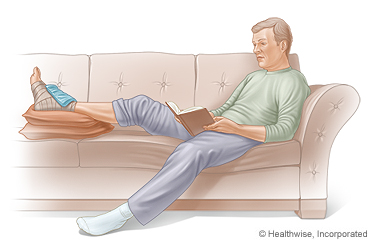
Overview
A strain happens when you overstretch, or pull, a muscle. A sprain occurs when you stretch or tear a ligament, the tough tissue that connects one bone to another. These problems can happen when you exercise or lift something or when you are in an accident.
Rest and other home care can help strains and sprains heal.
The doctor has checked you carefully, but problems can develop later. If you notice any problems or new symptoms, get medical treatment right away.
Follow-up care is a key part of your treatment and safety. Be sure to make and go to all appointments, and call your doctor if you are having problems. It's also a good idea to know your test results and keep a list of the medicines you take.
How can you care for yourself at home?
- If your doctor gave you a sling, splint, brace, or immobilizer, use it exactly as directed.
- Rest the strained or sprained area, and follow your doctor's advice about when you can be active again.
- Put ice or a cold pack on the sore area for 10 to 20 minutes at a time to stop swelling. Try this every 1 to 2 hours for 3 days (when you are awake) or until the swelling goes down. Put a thin cloth between the ice pack and your skin. Keep your splint or brace dry.
- Prop up a sore arm or leg on a pillow when you ice it or anytime you sit or lie down. Try to keep it higher than the level of your heart. This will help reduce swelling.
- Take pain medicines exactly as directed.
- If the doctor gave you a prescription medicine for pain, take it as prescribed.
- If you are not taking a prescription pain medicine, ask your doctor if you can take an over-the-counter medicine.
- Do exercises as directed by your doctor or physical therapist.
- Return to your usual level of activity slowly.
- Do not do anything that makes the pain worse.
When should you call for help?
Call your doctor now or seek immediate medical care if:
- You have severe or increasing pain.
- You have tingling, weakness, or numbness in the area.
- The area turns cold or changes color.
- Your cast or splint feels too tight.
- You have symptoms of a blood clot, such as:
- Pain in your calf, back of the knee, thigh, or groin.
- Redness and swelling in your leg or groin.
- You cannot move the strained part of your body.
Watch closely for changes in your health, and be sure to contact your doctor if:
- You do not get better as expected.
Where can you learn more?
Go to http://www.healthwise.net/patientEd
Enter H024 in the search box to learn more about "Strain or Sprain: Care Instructions".
Current as of: July 17, 2023
Author: Healthwise Staff
Clinical Review Board
All Healthwise education is reviewed by a team that includes physicians, nurses, advanced practitioners, registered dieticians, and other healthcare professionals.

